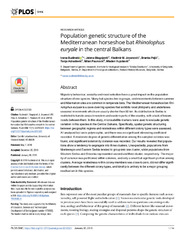Приказ основних података о документу
Population genetic structure of the Mediterranean horseshoe bat Rhinolophus euryale in the central Balkans.
| dc.creator | Budinski, Ivana | |
| dc.creator | Blagojević, Jelena | |
| dc.creator | Jovanović, Vladimir | |
| dc.creator | Bajić, Branka | |
| dc.creator | Adnađević, Tanja | |
| dc.creator | Paunović, Milan | |
| dc.creator | Vujošević, Mladen | |
| dc.date.accessioned | 2019-02-22T10:05:44Z | |
| dc.date.available | 2019-02-22T10:05:44Z | |
| dc.date.issued | 2019 | |
| dc.identifier.issn | 1932-6203 | |
| dc.identifier.uri | http://dx.plos.org/10.1371/journal.pone.0210321 | |
| dc.identifier.uri | http://www.pubmedcentral.nih.gov/articlerender.fcgi?artid=PMC6353099 | |
| dc.identifier.uri | https://radar.ibiss.bg.ac.rs/handle/123456789/3262 | |
| dc.description.abstract | Migratory behaviour, sociality and roost selection have a great impact on the population structure of one species. Many bat species live in groups, and movements between summer and hibernation sites are common in temperate bats. The Mediterranean horseshoe bat Rhinolophus euryale is a cave-dwelling species that exhibits roost philopatry and undertakes seasonal movements which are usually shorter than 50 km. Its distribution in Serbia is restricted to karstic areas in western and eastern parts of the country, with a lack of known roosts between them. In this study, microsatellite markers were used to evaluate genetic variation in this species in the Central Balkans. Specifically, spatial genetic structuring between geographic regions and relatedness within different colony types were assessed. All analysed loci were polymorphic, and there was no significant inbreeding coefficient recorded. A moderate degree of genetic differentiation among the sampled colonies was found, and significant isolation by distance was recorded. Our results revealed that populations show a tendency to segregate into three clusters. Unexpectedly, populations from Montenegro and Eastern Serbia tended to group into one cluster, while populations from Western Serbia and Slovenia represented second and third cluster, respectively. The majority of variance was partitioned within colonies, and only a small but significant portion among clusters. Average relatedness within colony members was close to zero, did not differ significantly between the different colony types, and kinship is unlikely to be a major grouping mechanism in this species. | en |
| dc.relation | info:eu-repo/grantAgreement/MESTD/Basic Research (BR or ON)/173003/RS// | |
| dc.rights | openAccess | |
| dc.rights.uri | https://creativecommons.org/licenses/by/4.0/ | |
| dc.source | PloS One | |
| dc.title | Population genetic structure of the Mediterranean horseshoe bat Rhinolophus euryale in the central Balkans. | en |
| dc.type | article | en |
| dc.rights.license | BY | |
| dcterms.abstract | Aднађевић, Тања; Будински, Ивана; Благојевић, Јелена; Пејић, Бранка; Јовановић, Владимир; Пауновић, Милан; Вујошевић, Младен; | |
| dc.rights.holder | © 2019 Budinski et al. | |
| dc.citation.issue | 1 | |
| dc.citation.volume | 14 | |
| dc.identifier.doi | 10.1371/journal.pone.0210321 | |
| dc.identifier.pmid | 30699143 | |
| dc.identifier.scopus | 2-s2.0-85060828170 | |
| dc.identifier.wos | 000457155600029 | |
| dc.citation.apa | Budinski, I., Blagojević, J., Jovanović, V. M., Pejić, B., Adnađević, T., Paunović, M., & Vujošević, M. (2019). Population genetic structure of the Mediterranean horseshoe bat Rhinolophus euryale in the central Balkans. PloS One, 14(1), e0210321. | |
| dc.citation.vancouver | Budinski I, Blagojević J, Jovanović VM, Pejić B, Adnađević T, Paunović M, Vujošević M. Population genetic structure of the Mediterranean horseshoe bat Rhinolophus euryale in the central Balkans. PLoS One. 2019;14(1):e0210321. | |
| dc.citation.spage | e0210321 | |
| dc.type.version | publishedVersion | en |
| dc.identifier.fulltext | https://radar.ibiss.bg.ac.rs//bitstream/id/4788/PLoSOne_2019_14_1_e0210321.pdf | |
| dc.citation.rank | M21 |

